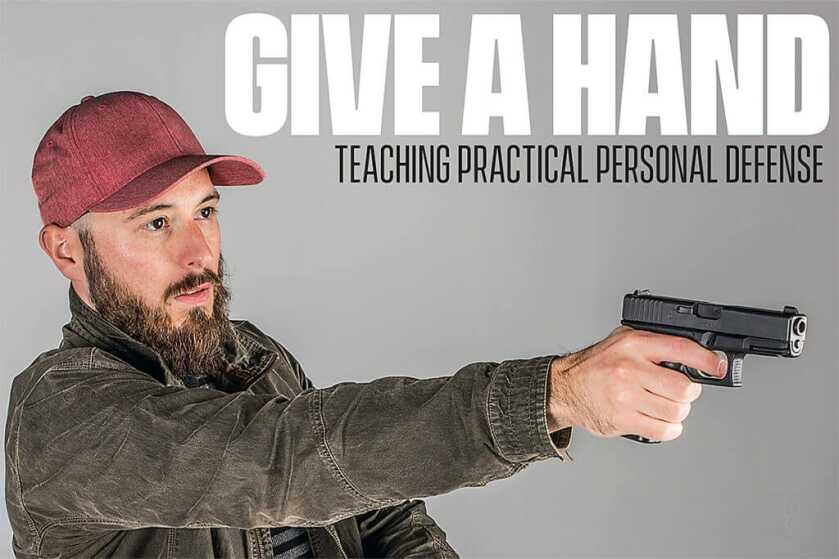
Editor’s Note: The following is a syndicated article by author George Harris that first appeared in USCCA’s Concealed Carry Magazine Volume 16, Issue 3, April 2019 under the title, “Give a Hand: Teaching Practical Personal Defense.”
Single-handed shooting is often overlooked until well into the progression of firearms training. It’s certainly easier to train and practice with two hands, but is it best to perfect two-handed techniques before transitioning to single-handed shooting and handling techniques?
From the casual shooter’s viewpoint, shooting with one hand may be a nice skill to attain but not totally essential. After all, we have two hands … so why not use them?
The competitive shooter may find shooting with one hand a requirement to compete within the rules of the game. The rules of an event may dictate the engagement of targets with either the strong or support hand only. Often, proficiency in shooting and handling a gun with a single hand makes the difference between winning and falling by the wayside from lack of speed, accuracy or both.
No Time for Games
Those who carry for personal defense have a greater investment in becoming proficient at using their sidearms with one hand. There are no hard-and-fast rules that come into play during a justified gunfight. Statistically speaking, someone engaged in a dynamic self-defense confrontation is more likely to experience the need to deliver ordnance with one hand. For this reason alone, a firearms instructor may want to integrate single-handed shooting and handling techniques into the training schedule sooner rather than later.
When teaching a student to operate a handgun with one hand, it is especially important to evaluate the size and chambering of the gun compared to the size of the shooter’s hand. Deficiencies masked by the use of two hands become apparent when only one hand is available to operate the gun, and recoil alone may be a serious factor when multiple shots are in order.
Measuring Up
Grip circumference and trigger reach are of primary consideration, although operation of other control features of the gun can’t be ignored. This applies to both hands since there are no guarantees that one or the other will be available at any given time. Keep in mind that dexterity, strength, range of motion and even size may differ from one hand to the other. Often there has to be a compromise to find the best option in the majority of situations.
Ideally, we can seat the gun in the web of the hand so that the barrel of the gun is parallel to the index finger in its natural extension along the side of the frame. This positions the muzzle to point at a target the same as if we were to point the index finger at the same target utilizing our natural eye/hand coordination. The thumb and middle finger should contact one another, fully encircling the grip to control vertical and lateral recoil during discharge. This also helps to prevent recoil from changing the position of the gun in the hand when firing multiple rounds.
Keep It Smooth
With the gun positioned in this manner, the trigger finger must be able to reach the trigger with full contact across the face of the trigger. This will help to move the trigger in a smooth, fluid manner, parallel to the gun from take-up to shot release, without lateral pressure pushing or pulling the muzzle off-target during the trigger stroke. Trigger manipulation trumps everything else; the muzzle must stay on the target until the bullet exits the barrel in order to achieve a hit. When the act of pulling the trigger causes the muzzle to deviate from pointing at what we intend to hit, satisfaction will not be realized. Have the students practice the “Wall Drill” with one hand to master proper trigger control and assess the need for improvement.
Practice Adaptation
Other operating features, such as the magazine release, slide stop and safety/decocking lever (if so equipped), should be considered as well. This is where handguns equipped with ambidextrous controls benefit single-handed shooting with either hand. In some cases, a student may have to adapt to using his or her index finger instead of his or her thumb to work the controls when he or she is running the pistol with his or her non-dominant hand.
One for All, All for One
As instructors, we should strive for all of our students to be able to operate all of the controls on their personal sidearms with either hand and without a shift of their grips. Realizing that this isn’t always possible, we have to be adaptable with techniques, ideas and sometimes equipment changes. One-handed shooting is an essential skill, and we must do all we can to help our students master it.
Discover how you can join nearly 300,000 responsibly armed Americans who already rely on the USCCA to protect their families, futures and freedoms: USCCA.com/gunsamerica.

Nice and important article. Thanks
May I suggest training on Rogersrangetx? The Rogers Range training focuses on about a third of two handed shooting, a third on strong hand shooting, and a third on support hand shooting. Been reserved for Top Tier elements for many years but now available at Mission Critical Training ranges. Unbelievable and state of the art. Great place and instructors.